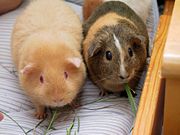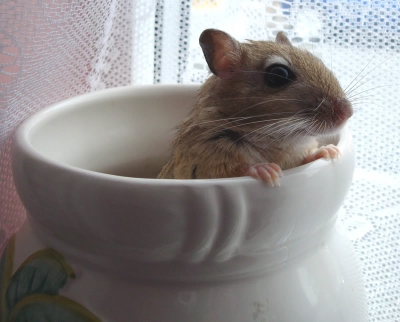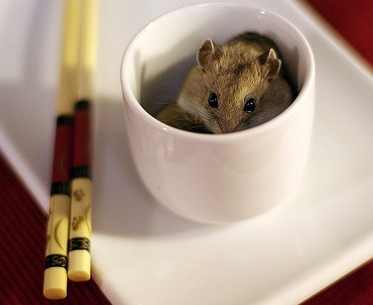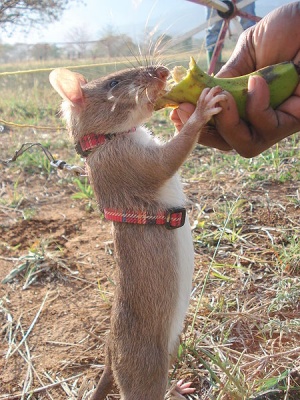
Guinea Pigs
Contents |
Where does the Guinea pig come from?
The Guinea pig also known as Cavy, originated in the Andes Mountains of South America. The people there use them as a food source. In the West, they have been a popular pet since the 16th century. They entered the show ring in the late 1800s in the United States. Life span of a Cavy is 7-12 years.
Appearance
The Guinea pig weighs about 1 1/2 to 2 1/2 lbs. and is 8-10 inches long. It has no tail. Average life span is about 4-8 years. Hair can be medium length or short and close to the body. Colors are shades of black, tan, brown and rust, bi- and tri-colored. There are different types of Cavies – the American is a Cavy with a short, smooth coat; the American Satin Cavy’s coat has a satin sheen; the Abyssinian Cavy has a short, rough coat with a minimum of eight rosettes; the Abyssinian Satin Cavy’s coat has a satin sheen; the Coronet is a longhaired, smooth-coated Cavy with a rosette on its forehead; the Peruvian Cavy has a long rough coat; the Peruvian Satin with a satin sheen coat; the Silkie is a longhaired, smooth coated Cavy, the Silkie Satin has a coat with a satin sheen; the Teddy, a Cavy with a short, curly, plush coat; the Teddy Satin with a satin sheen; the Texel has a long, curly coat; the White Crested is a shorthaired, smooth coated Cavy of sold color with a white rosette on the forehead. Satin Cavies are actually a mutation. The hair shafts are hollow and create a unique sheen to the coat. The Satins colors are very beautiful, particularly the reds, red-eyed oranges, solid silvers and solid goldens.
Personality
Guinea pigs are social animals and do better in pairs. (In fact, it’s illegal to own a single guinea pig in Switzerland.) Having more than one Guinea pig does not affect their bonding to you. With patience and time your Guinea pig will recognize you and respond to the sound of your voice. They like to be cuddled and held close to you for security.
Never keep 2 boars (males) together with a sow (female) as they will fight.
Environment
Guinea Pigs like to move around a lot and are very fast and need space. They must be kept in same-sez pairs.Your Guinea Pig needs a cage large enough to have room to move about.
Guinea Pigs should NEVER be housed with rabbits for the following reasons:
- Rabbits are a lot stronger than guinea pigs, they can easily hurt/kill a guinea pig without meaning to, simply by kicking out with their back legs.
- Also rabbits do tend to bully guinea pigs.
- They also have differing dietary requirements, so unless you intend to feed them separately you will be neglecting one pet’s needs: Guinea pigs need additional Vitamin C in their diets or they can become sick. But rabbits don’t, and too much vitamin C can make a rabbit ill.
- This is the most important reason: Rabbits carry bordatella, a disease which is fatal to guinea pigs.
Since they chew everything be sure the cage and anything in it is non-toxic and safe. The larger the cage, the happier your pet. Cages with solid bottoms and removable trays make for easier clean-up. Cages should be cleaned every week to 10 days. The cage should be kept in a light area, but out of sunlight and drafts and away from heaters.
Bedding for the cage should not have a strong odor to prevent respiratory problems. Recycled paper or aspen shavings are the best and are absorbent.
Wooden houses or plastic houses are fine. You’ll need a ceramic bowl or 2 for food and a rack on the cage for hay. A hanging water bottle should be attached to the side of the cage. Untreated wooden blocks will satisfy the need for gnawing. Check with your pet supplier for appropriate toys for your Guinea Pig. They also enjoy chewing on toilet paper and hand towel rolls, empty of course.
Feeding
Guinea Pigs don’t produce Vitamin C as other animals can, so they need foods and treats high in C. Ready mixed food can be purchased from your pet supplier and should be labeled for Guinea Pigs. They should have a fresh supply of timothy, oat or grass hay along with fresh fruits and veggies. Dispose of any uneaten fresh food daily. Give your Guinea Pig fresh water daily.
Your pet shop will have untreated small logs and other toys suitable for your Guinea pig. They will also have food designed specifically for the Guinea pig. You should provide TIMOTHY hay, green leafy vegetables and fruit. Apple seeds are toxic, but the meat of the apple is fine.
Note: Guinea Pigs suffer more frequently than other animals from heart attacks and strokes. The theory is that they are always on high alert as they are prey animals. If you suspect your guinea pig has had a stroke, it’s head tilts, eyes can’t focus properly, take to a vet immediately. They can recover with quick care.
More info
- Exercising Your Guinea Pig
- George the Guinea Pig
- Guinea Pig Ileus
- Guinea Pig Myths, Facts and Urban Legends
- How Guinea Pigs Communicate
- How to Handle a Guinea Pig
- Keeping Guinea Pigs
- Lice and Your Guinea Pig
- What cages, accessories and food do I need for a Guinea Pig?
Videos
NB: please note that this animal has had training for this. You’ll need a lot of time and patience to get the same result with your pet.



